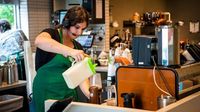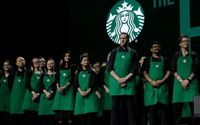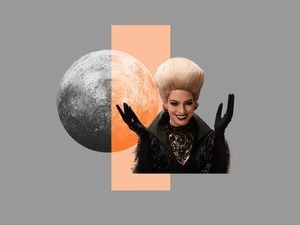Starbucks is set to implement a new dress code for its baristas starting May 12, 2025, that has sparked mixed reactions among employees. The company announced that employees will be required to wear solid black shirts and bottoms that are either black, khaki, or blue denim. This move aims to enhance the visibility of the iconic green aprons that have been a hallmark of the brand since their introduction in 1987.
The chain will provide each employee with two free black T-shirts as part of this change. According to Starbucks, the new dress code is designed to create a more consistent and familiar experience for customers visiting their stores across North America. A spokesperson for the company stated, "By updating our dress code, we can deliver a more consistent coffeehouse experience that will also bring simpler and clearer guidance to our partners, which means they can focus on what matters most, crafting great beverages and fostering connections with customers."
However, not all baristas are on board with the new policy. Several employees have voiced their concerns, emphasizing that this change may lead to additional out-of-pocket expenses for them. Jasmine Leli, a barista from Buffalo, New York, and a bargaining delegate for Starbucks Workers United, expressed frustration, stating, "Instead of addressing the most pressing issues baristas have been raising for years, Starbucks is prioritizing a limiting dress code that won’t improve the company’s operation. They’re forcing baristas to pay for new clothes when we’re struggling as it is on Starbucks wages and without guaranteed hours."
Neha Cremin, a barista working near Oklahoma City's LGBTQ+ community, echoed similar sentiments, worrying that the new dress code would prevent employees from wearing Pride or LGBTQ+ themed shirts, including those produced by Starbucks itself. "I don't see anything about the fact that workers are running around with two or three people running a busy, full café," Cremin said. "It’s taking away from the human connections that make Starbucks a pleasant place to go."
The new dress code is part of a broader strategy initiated by CEO Brian Niccol, who took over the company about seven months ago. Under his leadership, Starbucks has made several changes, including a reduction in menu items and new policies regarding customer behavior in cafes. Niccol has emphasized the importance of creating inviting spaces for customers, mentioning at a shareholder meeting last month, "We want to invite customers in, showcase our great coffee, provide a comfortable place to stay, and make them feel like their visit was time well spent."
Starbucks has a history of flexible dress codes, having previously allowed employees to express themselves through their clothing choices. In 2016, the company relaxed its dress code to embrace a wider range of styles, permitting colors beyond the traditional black and white, including gray, navy, and brown. The recent shift back to a more stringent dress code has raised eyebrows among employees who feel that the focus should be on improving operational issues such as understaffing and long wait times for customers.
Amidst the backlash, some employees have shared their perspectives on social media platforms. A Reddit thread among Starbucks partners revealed a mix of frustration and determination, with some discussing plans to overhaul their work outfits in light of the new requirements. One commenter lamented, "It's not like I would ever want to wear them outside of work, so I guess I just wasted my money on them since they're essentially useless to me now?"
Starbucks Workers United, representing more than 550 of Starbucks’ 10,000 U.S. stores, has voiced opposition to the new dress code, arguing that changes should not be made until a labor agreement is reached. The union contends that the focus should be on improving conditions for employees rather than enforcing a limiting dress code.
As the May 12 deadline approaches, the reactions from Starbucks employees highlight a growing tension between management's vision for the brand and the realities faced by baristas on the ground. While the company aims to create a more uniform and recognizable aesthetic, many employees argue that their concerns about working conditions, wages, and the overall customer experience should take precedence.
In the midst of these changes, Starbucks continues to explore operational adjustments to enhance both partner and customer experiences. The spokesperson for the company noted, "We're continuing to test and learn to ensure we make the right investments in staffing and deployment, processes, and algorithm technology to improve the partner and customer experience."
With the new dress code set to roll out soon, it remains to be seen how Starbucks will balance its branding initiatives with the needs and voices of its employees. As baristas prepare for the changes, they are left wondering whether this new policy will truly enhance the Starbucks experience or simply add another layer of complexity to their work lives.






